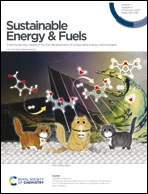Resourceful utilization of methylene blue-contaminated water for the fabrication of an ultra-stable supercapacitor device†
Abstract
The current work reports a unique solution for two of the major problems of the 21st century, dye-contaminated water and the increasing demand for energy storage devices. Methylene blue, from contaminated water, was utilized to enhance the electrochemical performance of a supercapacitor electrode through adsorption and subsequent stabilization. Firstly, carbon obtained from the carbonization of waste grass was converted to carbon–SnS2 composite through a single-step hydrothermal process. The synthesized composite was subsequently used to remove methylene blue from the contaminated water with a removal efficiency of 40 mg g−1 in 20 min. The adsorbed methylene blue was stabilized on the adsorbent through heat treatment, forming S- and N-doped carbon, thus enhancing the electrochemical performance of asymmetric supercapacitor device. The methylene blue-stabilized composite achieved highest specific capacitance of 426.5 F g−1 at 2 A g−1 in a 3-electrode setup. A device fabricated with this sample as the cathode and carbonized grass as the anode achieved a maximum specific capacitance of 98.3 F g−1 with an energy density of 44.3 W h kg−1 at a high power density of 1.8 kW kg−1. The device showed high capacitance retention of 97% after 10 000 charging–discharging cycles, which is excellent for practical applications.



 Please wait while we load your content...
Please wait while we load your content...